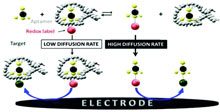Publication
711
Anal. Chem. , 84 (12), 5415-5420, 2012
DOI:10.1021/ac301048c
|
|
|
|
|
 |
Simple and Highly Enantioselective Electrochemical Aptamer-Based Binding Assay for Trace Detection of Chiral Compounds |
|
|
|
|
Lylian Challier, François Mavré, Julie Morea, Claire Fave, Bernd Schöllhorn, Damien Marchal, Eric Peyrin, Vincent Noël and Benoit Limoges
ITODYS, UMR 7086 CNRS, Université Paris Diderot, Sorbonne Paris Cité, 15 Rue Jean-Antoine de Baïf, F-75205 Paris Cedex 13, France
Laboratoire d’Electrochimie Moléculaire, UMR 7591 CNRS, Université Paris Diderot, Sorbonne Paris Cité, 15 Rue Jean-Antoine de Baïf, F-75205 Paris Cedex 13, France
Département de Pharmacochimie Moléculaire, UMR 5063 CNRS, Université Joseph-Fourier, 470 Rue De La Chimie, 38400 Saint-Martin d’Hères, France
A new electrochemical methodology is reported for monitoring in homogeneous
solution the enantiospecific binding of a small chiral analyte to an aptamer.
The principle relies on the difference of diffusion rates between the targeted
molecule and the aptamer/target complex, and thus on the ability to more easily
electrochemically detect the former over the latter in a homogeneous solution.
This electrochemical detection strategy is significant because, in contrast to
the common laborious and time-consuming heterogeneous binding approaches, it is
based on a simple and fast homogeneous binding assay which does not call for an
aptamer conformational change upon ligand binding. The methodology is here
exemplified with the specific chiral recognition of trace amounts of L- or
D-tyrosinamide by a 49-mer D- or L-deoxyribooligonucleotide receptor. Detection
as low as 0.1% of the minor enantiomer in a nonracemic mixture can be achieved
in a very short analysis time (<1 min). The assay finally combines numerous attractive features including simplicity, rapidity, low cost, flexibility, low volume samples (few microliters), and homogeneous format. |

